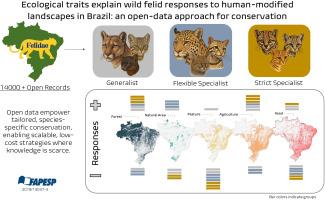Ecological traits explain wild felid responses to human-modified landscapes in Brazil: An open-data approach for conservation
IF 4.4
1区 环境科学与生态学
Q1 BIODIVERSITY CONSERVATION
引用次数: 0
Abstract
Understanding how wild felids respond to human-modified landscapes is critical for designing effective conservation strategies, yet comparative assessments across species remain scarce in tropical regions. Here, we assess the habitat selection and road sensitivity of nine wild felid species in Brazil using an integrative and scalable framework based entirely on open-access data. We compiled over 14,000 cleaned occurrence records and modelled habitat associations using generalized linear models across three spatial scales (5, 15, and 30 km). Species were grouped into three ecological categories: generalists, flexible specialists, and strict specialists, based on their ecological plasticity. Our results reveal marked interspecific variation in habitat preferences and responses to roads. While generalists like Puma concolor and Herpailurus yagouaroundi showed higher tolerance to anthropogenic environments, others like Leopardus geoffroyi exhibited more restricted patterns. Flexible specialists like Panthera onca and Leopardus pardalis avoided roads but used heterogeneous natural landscapes. Strict forest specialists (L. wiedii, L. guttulus, L. tigrinus) were highly dependent on forest cover and generally avoided open habitats. Notably, road effects were species-specific and not always aligned with ecological classification. Our findings emphasize that functional classification can aid in anticipating species vulnerabilities, but conservation actions must be tailored to species-level responses. This study highlights the potential of open biodiversity data to inform large-scale conservation planning for Neotropical carnivores, especially in data-poor regions.

生态特征解释了巴西野生动物对人类改造景观的反应:一种保护的开放数据方法
了解野生猫科动物对人类改造景观的反应对于设计有效的保护策略至关重要,但在热带地区,跨物种的比较评估仍然很少。在此,我们利用一个完全基于开放获取数据的综合可扩展框架,评估了巴西9种野生野地物种的栖息地选择和道路敏感性。我们编制了超过14000个清洁的发生记录,并使用三个空间尺度(5、15和30公里)的广义线性模型模拟了栖息地的关联。根据物种的生态可塑性,将其分为通才型、灵活专才型和严格专才型三个生态类型。我们的研究结果揭示了生境偏好和对道路的反应的显著种间差异。虽然像美洲狮和雅格鲁瓦迪这样的通才对人类环境表现出更高的耐受性,但其他像杰弗里奥帕达斯这样的动物表现出更有限的模式。像Panthera onca和Leopardus pardalis这样灵活的专家避开了道路,而是使用了不同的自然景观。严格的森林专家(L. wiedii, L. guttulus, L. tigrinus)高度依赖森林覆盖,一般避开露天生境。值得注意的是,道路效应是物种特异性的,并不总是与生态分类一致。我们的研究结果强调,功能分类可以帮助预测物种的脆弱性,但保护行动必须根据物种水平的反应进行调整。这项研究强调了开放生物多样性数据为新热带食肉动物的大规模保护规划提供信息的潜力,特别是在数据匮乏的地区。
本文章由计算机程序翻译,如有差异,请以英文原文为准。
求助全文
约1分钟内获得全文
求助全文
来源期刊

Biological Conservation
环境科学-环境科学
CiteScore
10.20
自引率
3.40%
发文量
295
审稿时长
61 days
期刊介绍:
Biological Conservation is an international leading journal in the discipline of conservation biology. The journal publishes articles spanning a diverse range of fields that contribute to the biological, sociological, and economic dimensions of conservation and natural resource management. The primary aim of Biological Conservation is the publication of high-quality papers that advance the science and practice of conservation, or which demonstrate the application of conservation principles for natural resource management and policy. Therefore it will be of interest to a broad international readership.
 求助内容:
求助内容: 应助结果提醒方式:
应助结果提醒方式:


